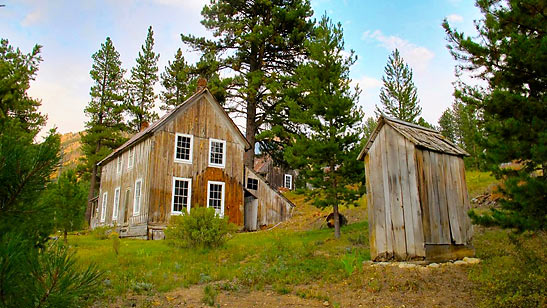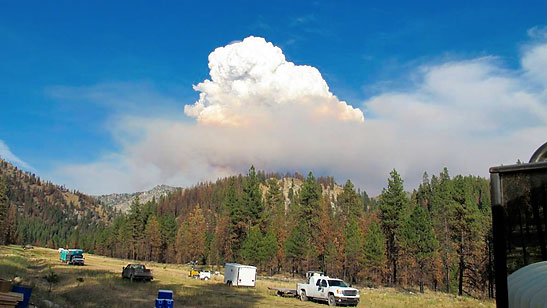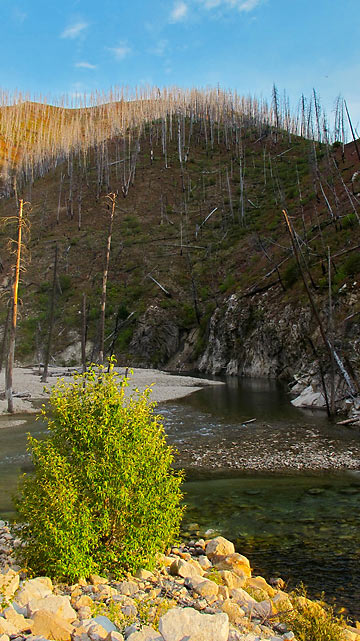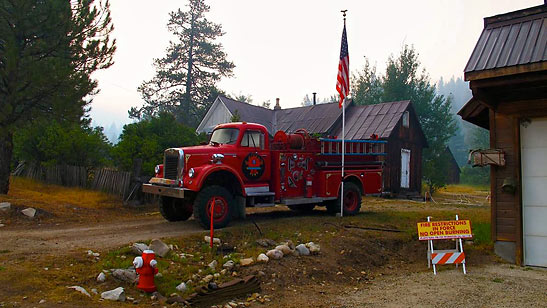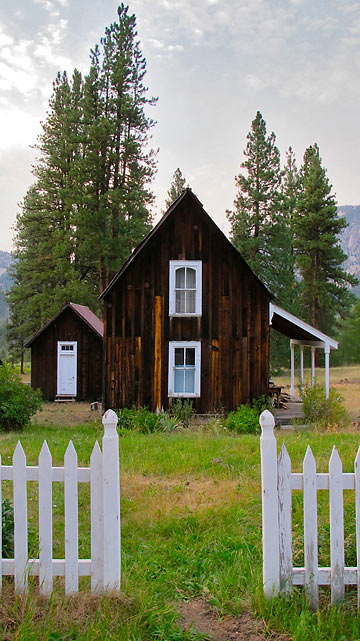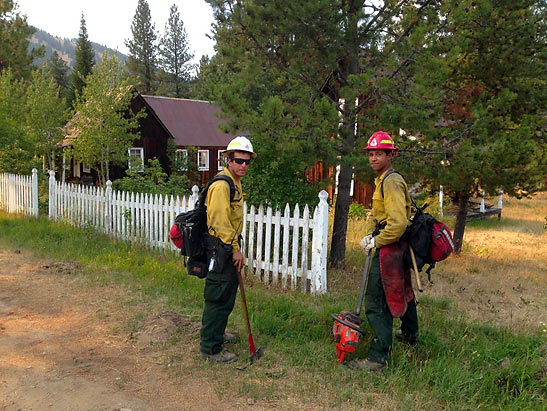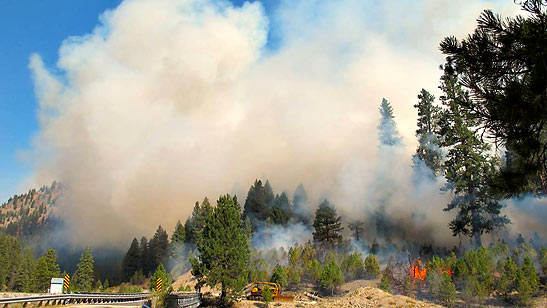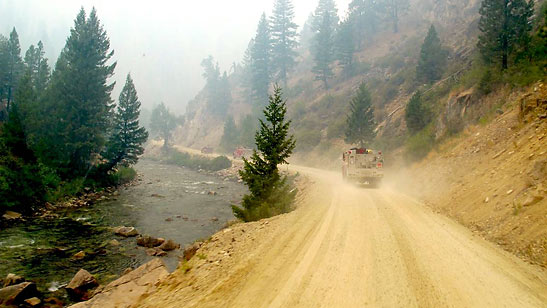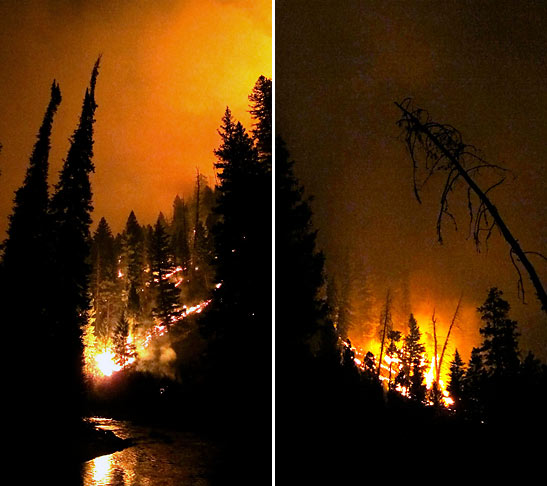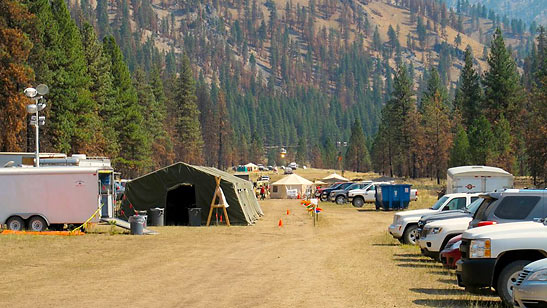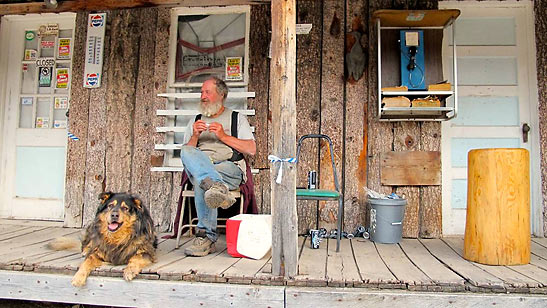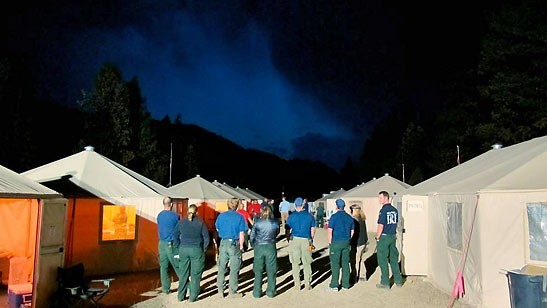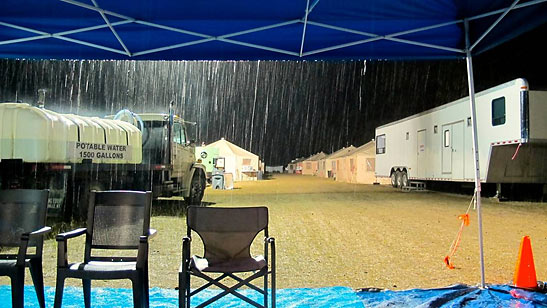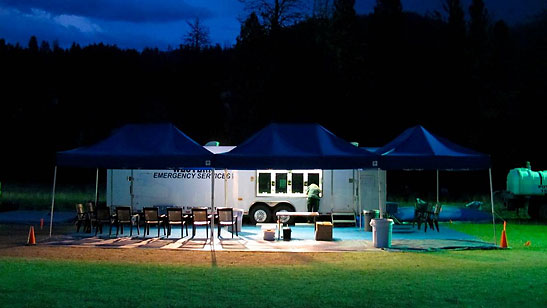 |
 |
|
 |
|
Little
Queens Fire –
8/17 8/18 8/19 When we got the call for the Little Queens fire, I looked up the national "Sit Report" straightaway. It stated that a fire of unknown origin had started two days earlier near Atlanta, Idaho and immediately flared up to 2,000 acres, threatening nearby homes and property. I then looked at a map to see where this "Atlanta" was located and was pleasantly surprised. A tiny, remote town next to the Sawtooth Wilderness area, in the middle of nowhere. Awesome. Back to the yard with my meticulously packed bags. Some last minute preparations and then into the trucks for a six hour drive to Eastern Oregon where we spent the night. 8/20 At dawn, we headed out toward Idaho City, northeast of Boise. Beyond this small town, a skinny, winding highway led us up and over a mountain pass to a primitive Forest Service road. Another two full hours of dusty driving brought us to our final destination, an alpine grass and dirt emergency airstrip. After being assigned a spot to set up our equipment, a mobile shower unit, we got to work. I couldn't understand why I was so thirsty, until I realized that the airstrip was nearly 5,000 feet above sea level. An awesome mushroom cloud of smoke from the fire billowed up from behind the ridge to the north. The cadence of helicopter blades, rumbling into and out of the compound, echoed off the neighboring canyon walls.
Throughout the day, more vehicles and personnel arrived. As is typical for a fire, and to my continuing amazement, another functioning city was set up by nightfall, complete with a large kitchen, dining tent, showers, mobile hand washing stations, bathrooms (port-a-potties, yum), and numerous yurts constructed for operations staff. This transient city would quickly come to accommodate an average of about 300 people.
Towards the end of the afternoon, the facilities lead asked if I would be able to temporarily supply the camp with fresh water. The National Preparedness Level had just been raised to 5 (the highest)*, indicating that fire base resources throughout the country were tapped out. As a result, the potable water truck that was supposed to be at our camp had been delayed at another fire. I was to acquire water from a fire hydrant 14 miles up the road in Atlanta to supply both the camp and our shower unit. I liked this idea a lot, as it got me closer to the fire, which I wanted to put my eyeballs to. Mandatory evacuations being in effect in the town itself, which made the situation even more dubious. The entire length of the gravel road to Atlanta runs along the Middle Fork Boise River, and the drive turned out to be terrifically beautiful. The super clear emerald waters of the river carve out the occasional deep pool, evincing even deeper bluish-green hues from the depths, with adjacent gray rock walls shooting vertically upward in a number of areas. The effect is striking. On the hills above lay massive evidences of previous fire activity, the flames of which completely decimating much of the entirety of the forest as far as the eye could see. Thousands upon thousands of blackened toothpicks line the hillsides, with barely a leaf or twig left on any, starkly contrasting the blue sky and clouds above.
I had heard that there was a lot of gold in Idaho, and found out how true this was by the numerous claim signs pegged with almost perfect regularity along the way. Every 100 yards or so of the river has been claimed by gold miners. The occasional floating dredge could be seen tied up to a tree along the river, with evidence of semi-permanent encampments along the riverbank. Arriving in Atlanta close to dusk, I found the hydrant just outside the quaint fire department, complete with an ancient fire engine parked out front. Parts of the town looked as if little had been changed since the early part of last century, with all the idiosyncratic architectural signatures characteristic of gold rush towns. Charming. The fire was advancing toward the small town on the ridge to the north, with large columns of smoke rising from just behind the ridge line into the darkening sky. With that foreboding skyline looming horizon, Atlanta definitely didn't feel like a place you'd want to be owning a home at the moment. Water acquired, I made my way back to fire camp, working until about one in the morning, the 19 hour work day behind me.
8/21 The next day arrived with normal fire camp routines establishing themselves quickly. Breakfast and coffee, attending to the shower unit, supplying the camp with potable water, and the like. About 40 low-risk prisoners from a local jail made their rounds, helping out in the kitchen and wherever else they could, including at our shower unit. Throughout the day, along with the firefighters and other staff, they would also take trips down to our unit to either empty our trash cans, or for a wash. It was interesting to hear their stories. Wanting to allow a good measure of deference in consideration of the new lives they had ahead of them (almost all were close to parole), I hesitated to ask whatever it was that had brought them to their current dispensations, but inevitably the answer would either be offered, or I would just plainly ask them if the moment felt right. To my amazement, several stated that they were in jail for DUI's, and at least one had garnered a hefty sentence for his first offense. When I arrived in Atlanta in the early evening, the fire was obviously advancing very quickly over the ridge. The previous day I had seen only plumes of smoke, but tonight, I could actually see the fire. Oddly, two Apache helicopters were flying low around the town. To my surprise, one of the Apaches dipped toward the tree line and eventually landed in a field just beyond my view, sending up a dust cloud. I wasn't sure what to make of these military helicopters, but was sure by the time I left was that the fire was indeed marching toward Atlanta at a marked pace. 8/22 Back at the hydrant toward dusk, the fire seemed to be a bit closer, but not by much. A two-prop airplane buzzed around the ridge line, moving very quickly. Waiting for my tank to fill, I could also see what appeared to be a C-130 approaching the fire. Eventually, the two-prop airplane and the C-130 converged, with the smaller plane in the lead. The C-130 followed closely, and at certain points along the ridge, a trail of smoke would proceed from the two-prop airplane. Wherever the smoke was produced, the C-130 bombed out a trail of water. I found a great time lapse sequence of the Little Queens fire taken on this day near the ICP at the fire base, by Kyle Ford. It's totally worth a gander.
8/23 News arrived the next afternoon that a back burn had been started near Atlanta,** and with an unusually busy work day in the books, I had to head out near dark. Being so far out in the wilderness, radio signals were spotty, but I managed to pick up a radio station that was broadcasting Idaho folk music. When I arrived in Atlanta, I couldn't believe my eyes. What had the day before only been a fire on a ridge line more than a mile away, as the crow flies, had turned into a veritable firestorm. The entire ridge was ablaze, with fire as close as a few hundred yards in front of where I was standing at the hydrant. Alone on the dirt road, I felt like I was in a video game, about to charge off into the forest to tackle a thousand awaiting hellion ghouls, with many glowing upwells of fire and smoke and sparks setting the scene. The sight was truly amazing. As I waited for my tank to fill, a man in his thirties drove up, hopped out of his truck, and asked if I was waiting to use the pay phone (yes, pay phone) next to the fire station. I said, "No," and he made his way over to the phone to start his call. I had left the door to my truck open, still listening to the folk music I had been entertaining myself with earlier. Just as I was adjourning my water gathering business, the fellow on the phone ended his call and headed my way. Pointing to the open door of my truck he asked, "Hey, is that Bill Coffey?" I replied that I had no idea, and that I had just found this awesome radio station with weird folk music on the way up. He explained to me that the song playing was by Bill Coffey and Ned Evett, who were well known folk musicians in the Idaho area, and that being a big fan, he had seen them play live on several occasions in the Boise area, his home town. Proceeding from this mutual introduction, with the smell of smoke and a nearby threatening fire, began a surreal Twilight Zone-caliber conversation about the Idaho folk music scene. Eventually, we got back to the reality of what was going on around us, and he explained to me that he worked for the Forest Service, having just debarked as the advisor from the heli-torch copter that had dispensed flaming golfball-sized fire pellets throughout the area to the north of us in an attempt to save the town. Since the winds were favorable that afternoon, the decision was made to make an aerial back burn as close to the town as possible, in an attempt to make the fire burn back into itself, thereby eliminating the threat of it advancing out of control toward Atlanta. So far the plan was working just about how they wanted it to. 8/24 The previous day's back burn north of Atlanta had been effective, but only to a certain measure. The worry was that the fire would skip over the river, and threaten the southern end of the town, so it was decided that more back-burning was required. Starting from Atlanta and moving toward the fire camp at the landing strip, fire crews would start fires along the northwest side of the road, to the distance of about five miles. With the same intent as the heli-torch the day before, the hope was that the subsequent fire would then again burn northward, into the original fire advancing towards Atlanta, meet somewhere in the middle, and be rendered ineffective.
8/25 – Close Encounters of
the Wolf Kind In the afternoon, I was informed that the back burn had progressed to the point where there was some debate among the overhead as to whether they would allow any travel to Atlanta. It was explained to me that any number of hazards could befall me on my trip: Burning trees on the road, landslides, road collapse, and burning material on the roadway. (Hmmm, the "any number of hazards" list presented to me did not seem to include wolves.) Towards evening, I went to see the head of logistics for the official word. After about ten minutes of deliberation and several radio calls to Atlanta, he told me soberly, "You can go, but be very, very careful." It was decided that I would make my way to the Queens River bridge about ten miles up the road, stop, and wait for a front loader to meet me to clear the road of burning material along the back burn. Among the normal operations transit making their way along that road at any given time, I was the only vehicle approved to make the trip until dawn. Walking out of the logistics yurt, I was elated about this upcoming drive into the unknown. After a brief chat with John, the Forest Service agent manning the check-point, I headed off toward Atlanta. It was dark by this time, and eventually, the pronounced glow of fire was seen on the horizon, and it wasn't long before I had reached the bridge. The volume of fire immediately adjacent to the road was remarkable. I parked the truck and hopped out with my camera, in awe of what I was seeing. The entire hillside was ablaze, as if it had just been lit. The stream below the bridge reflected the fire gracefully. At times, entire trees would torch, basking the small valley I was looking up into with an almost daylight quality of light. About a half hour of waiting for the front loader in the books, I decided to walk up the road to see if I could possibly make it to Atlanta without any assistance. Chunks of wood were burning in the roadway, having rolled down from the steep hill above. Small landslides of dirt and rocks could also occasionally be seen or heard. About a half mile into my walk, I found a large burning stump stationed squarely in the middle of the road. I realized there would be no way to move it with either my hands or my truck, so my quest for water wasn't going to be possible without the loader. I made my way back down to the bridge and paused to look out at the fire and take a few more pictures. I decided that if the front loader hadn't arrived by now, it probably wasn't going to make it at all, and that I should probably head back to camp in about ten or fifteen minutes. Any more than that would be a waste of time. I looked out over the stream and fire for another five minutes, snapping some parting shots. Having my fill of the amazing view, I turned to go back to the truck, which was parked about 50 feet from me, headlights still on. To my utter amazement, standing in the middle of the road between myself and the truck, only 30 feet away, staring at me, was a big white wolf.
Version #1 of my reaction to seeing a wolf (much preferred)
– Version #2 of my reaction to seeing a wolf (perhaps
a more accurate version of events) – I was absolutely stoked by this encounter, but wasn't sure this story would be believed by those back at camp. I had never seen a wolf in the wild before, and hadn't to my knowledge met anyone who had, especially at such close proximity. Arriving at the Forest Service checkpoint, I got out of the truck and immediately started with John: "You will probably never believe this, but…" After relaying the wolf story to him, he stated that he had also seen the same white wolf, and in the same general area of the bridge the night before. 8/26 John mentioned my wolf encounter the next morning to some of the staff. At least one more sighting of the wolf had been reported. Members of a hand crew had seen the wolf upstream from the bridge, and had found a dead deer some distance up the stream valley. The deer was its kill, of course, and the reason it had been lingering in the area. The logistics lead saw me later in the evening and commented somewhat sternly. "You know," he said with furrowed brow and concerned tone, "the wolf is the only animal that kills for sport. You're very lucky." Given that I had been standing on the bridge for about five minutes taking pictures of the fire before I turned and actually saw the wolf, I almost have to agree with him. Who knows how long it had been sizing me up? Had it been in a pack, I may have been at such a risk. However, given how skinny I am, I believe any wolf would consider me an unsavory target, unworthy of the effort.
8/27 In the afternoon I was able to take a bit of a break in Atlanta to take some pictures after filling my tank. The citizens turned out to be as quirky as the architecture. I chatted with a fellow that looked much like a stereotypical gold miner who told me that he was working a goldmine that his father had passed down to him from his grandfather, all of whom had been able to make a living in it since the early 1900's. Moving on, I passed what appeared to be a social club/antiques store, and glanced inside. The building was dark, with not a single light on inside, but I could distinctly hear the sound of two men chatting casually and a parrot squawking in the background. As I made my way up down the street I spotted a bearded man rolling a cigarette on a storefront porch, drinking a beer, with a big fluffy dog at his feet, which also looked like it had just drank a few beers. I engaged him in conversation and he explained to me that the town had been pretty wild back in the 70's before the police heard about it and decided making appearances. He pointed at the pay phone (yes another one) on the porch right next to us, and said that up until three months ago, you could call anywhere in the world on this phone for free. I later learned from someone else that Canadian gold prospectors had taken liberties with the phone, using it to dial 1-900 numbers (apparently these still exist too) ending the odd privilege once and for all. As we chatted, I looked back over to the social club antiques store. A man was driving away on a four-wheeler ATV, a parrot cage strapped to the back seat rack. The green parrot could be seen swinging on his swing as they drove away down the road. "Now this is my kind of town," I thought. I thanked the man for his time and the conversation and started walking back towards my water truck. He yelled, "Hey! You ain't got a joint do ya?!" "No," I replied. "All right then, get out of here!" he bellowed.
8/28 The back burn, carefully monitored, advanced beyond the road toward the main fire, with an effective degree of success. Hot spots along the road were extinguished to prevent subsequent flare-ups and a potentially catastrophic jump across the river. 8/29 8/30 The final days of the Little Queens engagement came with a dramatic reduction in resources and personnel. The base camp was briefly moved to the Forest Service airstrip, one mile north of Atlanta. The two remaining hand crews monitored the road to ensure no hot-spots would flare up and cause the fire to jump the river. The fire at this point was only 20% contained, but since it was burning into wilderness and not towards any other man made structures, the decision was made to demobilize. 9/2 Official de-mobe orders given. 9/3 We pack up and leave Atlanta. We spend two days in Boise, hoping to be picked up by one of the many other Idaho wildfires. This didn't happen. Home sweet home on the evening of the 5th. No wolf nightmares. Yet.
Height of resources: Cost of a Sikorsky helicopter, used for water drops: $8,000.00 an hour. Total cost of Little Queens fire: $4.6 million
*The last time the National Interagency Fire Center raised the National Preparedness Level to 5 was in July of 2008. **Aerial Firing Operations Begin (from Inciweb) Incident: Little Queens Wildfire Aerial ignition started around 2 pm this afternoon to reduce the fuels on the south slopes north of Atlanta. This will reduce the chance of extreme fire behavior and limit fire movement toward the community. The operation is expected to continue into late evening and will be monitored throughout the night. Based on today's burnout results, and tomorrow's weather conditions, burnout operations may continue on Saturday. Related Articles: |
|
This site is designed and maintained by WYNK Marketing. Send all technical issues to: support@wynkmarketing.com








